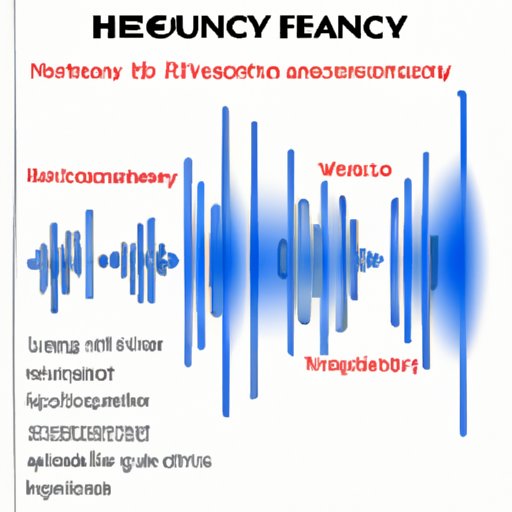Introduction
Sound is a form of energy that travels in waves and creates vibrations that can be heard. It is an integral part of everyday life, from the birds chirping outside our windows to the music we listen to while driving. But how does sound actually work? This article will explore the physics, anatomy, and technology behind sound to provide a comprehensive understanding of how sound works.

Physics of Sound: Exploring How Vibrations Create Sound
At its core, sound is created by vibrations. Every object has its own natural frequency, which is determined by its shape and size. When an object vibrates, it creates sound waves that travel through air or other mediums until they are heard by a listener. The amplitude of the vibrations determines the loudness of the sound, while the frequency determines the pitch.
For example, when a guitar string is plucked, it vibrates at a certain frequency and creates sound waves in the air. These sound waves travel to the listener’s ear and are then interpreted as a musical note. Everyday objects like phones, fans, and cars all create sound through vibrations.
The Science of Acoustics: Examining How Sound Travels
Acoustics is the study of how sound moves through different mediums. Sound waves travel differently depending on the medium they are traveling through. In air, sound waves travel in a straight line and can be reflected off of walls and other surfaces. In water, sound waves travel faster and can travel up to four times farther than in air.
The environment a sound wave is traveling through can also have an effect on its quality. For example, a large open space with hard walls and floors will cause sound waves to bounce off of the surfaces, creating an echo. This effect is known as reverberation, and it can be used to enhance the sound of a room or reduce its clarity.
What is the Frequency of Sound? A Look into the Physics of Sound Waves
Frequency is the number of times a sound wave vibrates in one second. It is measured in Hertz (Hz), and it determines the pitch of the sound. Low-frequency sounds have a lower pitch, while high-frequency sounds have a higher pitch. Humans can typically hear frequencies between 20 Hz and 20,000 Hz.
Different frequencies of sound can have different effects on the listener. Low-frequency sounds can produce a feeling of relaxation, while high-frequency sounds can be energizing. Certain frequencies can even be used to heal physical and psychological ailments. According to a study published in Frontiers in Neuroscience, “Low-frequency acoustic stimulation can activate various physiological systems, including the autonomic nervous system, endocrine system, and immune system.”

Deconstructing How We Hear: The Anatomy of the Ear and How It Processes Sound
The ear is an incredibly complex organ that is responsible for helping us hear. It consists of three parts: the outer ear, the middle ear, and the inner ear. The outer ear collects sound waves and directs them into the ear canal. The middle ear amplifies the sound waves and transmits them to the inner ear. The inner ear is the most complex part of the ear and is responsible for interpreting the sound waves into electrical signals that are sent to the brain.
The ear is also susceptible to hearing loss and other disorders. Common hearing disorders include tinnitus, hyperacusis, and presbycusis. Tinnitus is a condition characterized by ringing in the ears, while hyperacusis is an increased sensitivity to certain frequencies of sound. Presbycusis is an age-related hearing loss that typically occurs in older adults.
Technology of Sound: How Engineers Use Sound to Create Music and Audio Experiences
Sound engineers use audio equipment to record, mix, and manipulate sound. They use microphones to capture sound, mixers to adjust the levels of the sound, and speakers to amplify the sound. They can also use sound processors to add effects such as reverb and delay. By utilizing these tools, engineers can create unique audio experiences.
Modern technology has also enabled engineers to create virtual instruments and digital soundscapes. Virtual instruments are computer programs that allow users to create sounds without having to play an actual instrument. Digital soundscapes are collections of sounds that can be used to create immersive audio environments. Both of these technologies are increasingly being used in the music industry.

Exploring the Effects of Sound on Our Minds and Bodies: A Look at the Power of Sound
Sound has a profound effect on our minds and bodies. On a physiological level, sound can affect our heart rate, blood pressure, respiration, and hormone levels. On a psychological level, sound can evoke emotions and alter our mental states. Research has shown that certain frequencies of sound can be used to reduce anxiety and stress, improve focus and concentration, and even help with pain relief.
Sound therapy is becoming increasingly popular as an alternative treatment for a variety of conditions. According to a study published in Frontiers in Psychology, “Sound therapies are effective treatments for a range of psychological and physiological disorders, including depression, anxiety, insomnia, and chronic pain.”
Conclusion
This article has explored the physics, anatomy, and technology behind sound to provide a comprehensive understanding of how sound works. We have seen that sound is created by vibrations, that it travels differently depending on the medium it is traveling through, and that different frequencies of sound can have different effects on the listener. We have also looked at how sound engineers use technology to create music and audio experiences, and how sound can be used to heal and improve wellbeing. Understanding how sound works is essential for anyone looking to create or experience sound in new and exciting ways.
(Note: Is this article not meeting your expectations? Do you have knowledge or insights to share? Unlock new opportunities and expand your reach by joining our authors team. Click Registration to join us and share your expertise with our readers.)
